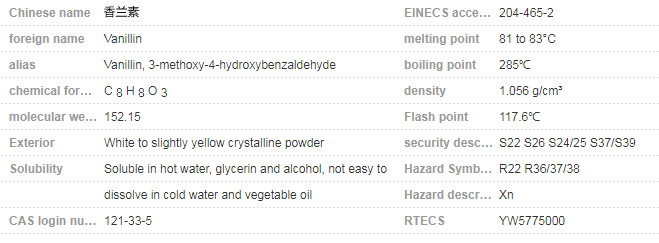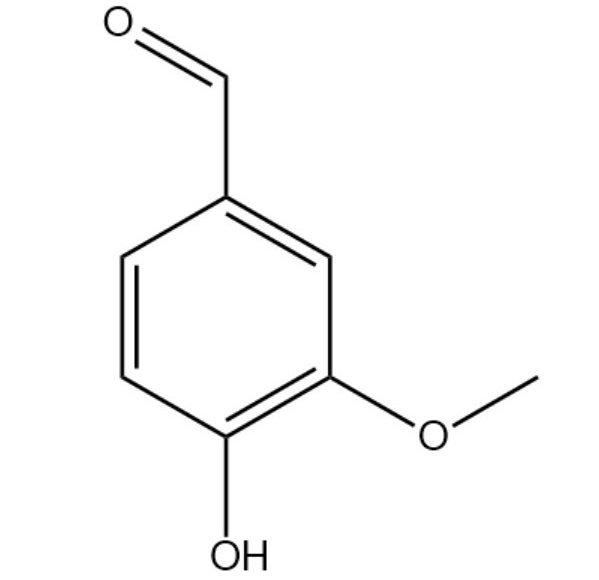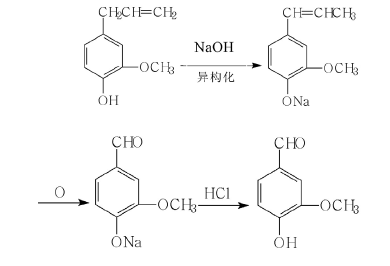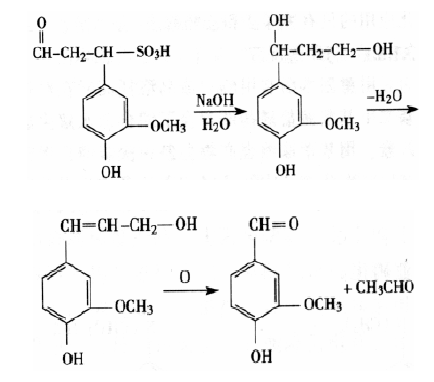Vanillin
Vanillin, the chemical name is 3-methoxy-4-hydroxybenzaldehyde, is an organic compound extracted from the Rutaceae plant vanilla bean, which is white to slightly yellow crystals or crystalline Powder, slightly sweet, soluble in hot water, glycerin and alcohol, insoluble in cold water and vegetable oil. The aroma is stable and not volatile at higher temperatures. It is easy to be oxidized in the air and easy to change color when it encounters alkaline substances.
Vanillin has the aroma of vanilla bean and strong milky aroma, which can enhance and fix the aroma. It is widely used in cosmetics, tobacco, cakes, candy and baked food industries. It is one of the world's largest synthetic spice varieties. , Industrial production of vanillin has a history of more than 100 years. The recommended dosage of vanillin in the final flavored food is about 0.2-20000 mg/kg. According to the regulations of the Ministry of Health of my country, vanillin can be used in formula food for older infants, young children and cereals for infants and young children (except infant formula cereal powder), and the maximum dosage is 5mg/mL and 7mg/100g respectively. Vanillin can also be used as a plant growth promoter, a fungicide, a lubricating oil defoamer, etc. It is also an important intermediate for synthetic drugs and other fragrances. In addition, it can also be used as a glazing agent in the electroplating industry, as a ripening agent in agriculture, as a deodorant in rubber products, as an anti-hardening agent in plastic products and as a pharmaceutical intermediate, etc. , is widely used.


Introduction
The chemical name of vanillin is 4-hydroxy-3-methoxybenzaldehyde, also known as methyl protocatechualdehyde and vanillin. One of them, with sweet bean and powder aroma, can be used as fixative, coordinating agent and flavoring agent, widely used in food, beverage, cosmetics, daily chemicals and medicine and other industries. The proportions used in downstream industries are about 50% for food additives, 20% for pharmaceutical intermediates, 20% for feed additives, and about 10% for other uses.
Vanillin is currently one of the most used food flavoring agents in the world, and has the reputation of "the king of food flavors". It is mainly used as a flavor enhancer in the food industry and is used in cakes, ice cream, soft drinks, chocolate, baked candy And alcohol, the added amount is 0.01%-0.04% in cakes and biscuits, 0.02%-0.08% in candy, the maximum amount used in baked goods is 220mg·kg -1 , and the maximum amount used in chocolate is 970mg·kg - 1. It can also be used as a food preservative additive in various foods and seasonings; in the cosmetics industry, it can be used as a flavoring agent in perfumes and creams; in the daily chemical industry, it can be used in daily chemicals Modified aroma; in the chemical industry, as a defoaming agent, vulcanizing agent and chemical precursor; can also be used in analysis and detection, such as for testing amino compounds and certain acids; in the pharmaceutical industry, as an odor shielding agent. Because vanillin itself has bacteriostatic effect, it can be used as a pharmaceutical intermediate in the pharmaceutical industry, including in the treatment of skin diseases. Vanillin has certain antioxidant and cancer prevention effects, and can participate in the signal transmission between bacterial cells. In the future, these potential application fields will promote the rapid growth of the market demand for vanillin. By 2019, the global market for vanillin will be The annual consumption is about 20,000 tons.
Basic Information
Name: Vanillin; 3-methoxy-4-hydroxybenzaldehyde
Chemical formula: C8H8O3
Molecular weight: 152.15
CAS Number: 121-33-5
EINECS Number: 204-465-2
Physical and chemical properties
Density: 1.056g/cm 3
Melting point: 81-83℃
Boiling point: 285℃
Flash point: 117.6℃
logP: 1.19
Refractive index: 1.588
Appearance: White to slightly yellow crystalline powder
Solubility: Soluble in hot water, glycerin and alcohol, not easy to dissolve in cold water and vegetable oil
Molecular structure data
1. Molar refractive index: 41.56
2. Molar volume (cm 3 /mol) : 123.5
3. Isometric specific volume (90.2K): 324.0
4. Surface tension (dyne/cm): 47.3
5. Polarizability: 16.47
Computational Chemistry Data
1. Hydrophobic parameter calculation reference value (XlogP): 0
2. Number of hydrogen bond donors: 1
3. Number of hydrogen bond acceptors: 3
4. Number of rotatable chemical bonds: 2
5. Number of tautomers: 5
6. Topological molecular polar surface area: 46.5
7. Number of heavy atoms: 11
8. Surface charge: 0
9. Complexity: 135
10. Number of isotope atoms: 0
11. Determine the number of atomic stereocenters: 0
12. The number of indeterminate atomic stereocenters: 0
13. Determine the number of chemical bond stereocenters: 0
14. Uncertain number of chemical bond stereo centers: 0
15. Number of covalent bond units: 1
Application in food storage and preservation
Food preservatives are divided into two categories: natural preservatives and chemical preservatives, which are used in food production, circulation, storage and other processes to maintain food sensory properties, improve edible value, and prolong storage time. Compared with chemical preservatives, natural preservatives have the advantages of being harmless to the environment, low production cost, good biocompatibility, and good preservation effect. Vanillin in food can be accurately detected by conventional methods such as UV-Vis spectrophotometry, chromatography , electrophoresis, etc. It is a kind of food preservative with high safety. The application of vanillin in food storage and preservation can be divided into bacteriostasis, anti-oxidation, stabilization of other components in food and inhibition of respiration rate.
Bacteriostatic
Vanillin is a natural bacteriostatic agent, which is often combined with other antibacterial methods in the food field, and the antibacterial effect of vanillin on different bacterial species is different. The bacteriostatic effect of vanillin is related to its concentration and pH value. Higher vanillin concentration and lower pH value are both beneficial to improve the bacteriostatic effect of vanillin. The bacteriostatic effect of vanillin on different bacterial species Compared with other strains, vanillin has better bacteriostatic effect on Escherichia coli. Vanillin has an inhibitory effect on a variety of yeasts, and a high concentration of vanillin is beneficial to improve its bacteriostatic effect, but a high concentration of vanillin cannot kill yeast instantly. Compound fresh-keeping realizes the synergistic effect between fresh-keeping agents (or fresh-keeping methods), and is a generally accepted method for preserving fresh-keeping of fruits and vegetables. For Aspergillus contamination, the effective bactericidal dose of vanillin alone is 0.5%, and the mixture of 0.05% vanillin and 0.0025% cinnamaldehyde can play a bactericidal effect.
Vanillin also plays an important role in assisting bacteriostasis and bactericidal. In the current production process, heat sterilization is still the most common sterilization method in fruit juice processing, and its treatment methods are generally pasteurization and high temperature instantaneous sterilization. Traditional sterilization methods often lead to the destruction of nutrients in juice and browning of products.
Anti-oxidation
The mechanism of action of antioxidants with similar structures is different. Vanillin mainly accelerates the scavenging of free radicals by oxidizing the product vanillic acid . The antioxidant effect of vanillin can significantly prolong the shelf life of oily food and has a negative effect on its rancidity. cover up. The isomer of vanillin, o-vanillin (3-methoxy-2-hydroxybenzaldehyde), has been shown to scavenge peroxynitrite anions, but is not a good free radical scavenger .
Other ingredients in stabilized food
Studies have shown that the reaction product of vanillin helps to stabilize other ingredients in food: Resveratrol is a natural functional ingredient. In order to improve its stability and give full play to its functional effect, the reaction of vanillin and chitosan The resulting reticulated chitosan microspheres are coated with resveratrol, which helps to control the release of resveratrol; the condensation product of vanillin and amino group has a good ability to complex with metal ions, which can effectively improve the release of resveratrol. Stability of Included Substances.
Security and Issues in Applications
Vanillin is a natural plant component and is recognized as a safer food additive. Due to the small amount of its addition in food, as of 2015, no reports about vanillin being harmful to human body have been found. In my country, there is no restriction on the addition of vanillin in other products, except that vanillin cannot be detected in foods for infants and young children aged 0-6 months.
The safety of vanillin is closely related to its use characteristics. Vanillin has the functions of flavor enhancement, bacteriostasis, anti-oxidation, and stabilization of food ingredients. It is a natural food additive with multiple functions, and low doses can play multiple roles. Vanillin can effectively reduce the levels of serum triglycerides and triglycerides combined with various lipoproteins in experimental mice after being ingested with daily diet. The amount used in food is consistent. Some scholars have proposed that the level of antioxidant active substances in the blood of mice increases with the increase of vanillin concentration, indicating that the antioxidant properties of vanillin may play a greater role in daily health care. . Therefore, the multi-action and health-promoting properties of vanillin in low doses are the basis for its safety in use.
However, the addition of vanillin may also have a bad effect on the preservation of fruits and vegetables, which is the main problem in the application of vanillin. It was reported that the VC content of pineapples coated with vanillin film decreased rapidly and was lower than that of the control group when stored at 10°C. Although vanillin treatment could enhance the yellow color of pineapples, it increased the attractiveness of fruit appearance and resulted in nutritional loss of ingredients. In addition, because vanillin itself has a strong milky aroma and is unstable when heated, adding it to food will also affect the inherent aroma of food raw materials. In production, the amount of vanillin added should be strictly controlled according to the actual situation, and the production and processing technology and operation should be strictly standardized to avoid adverse effects on the sensory quality of food. For how to effectively avoid the problems caused by vanillin's own characteristics, it is necessary to conduct in-depth research on its mechanism of action, processing technology and other aspects.
Overview of my country's Vanillin Market
China has become a major producer and supplier of vanillin. In 1983, my country formulated the national standard GB 3861-1983 for vanillin products, and completed the revision of GB 3861-2008 in 2008. In the 2008 version of the standard, gas chromatography was used to analyze the purity of vanillin products. The purity is above 99.5%. At the same time, the content of impurities such as guaiacol, ortho-vanillin, and 5-aldehyde vanillin in the vanillin product can also be analyzed, which is very beneficial for controlling the product quality.
As of 2019, the total global vanillin output is nearly 20,000 tons, and my country's vanillin output accounts for about 70% of the global total. The production technology of the product has reached the international advanced level. The vanillin products produced in my country have the characteristics of good quality and stable performance, and the price of the same vanillin products is lower than that of foreign countries, so they have strong competitiveness in the global market. my country's vanillin has an annual export volume of nearly 10,000 tons, and enjoys a good reputation in North America, Europe, Southeast Asia and other places. At the same time, as of 2019, the annual consumption of vanillin in my country is 2000-2500t. Among them, the food industry accounts for 55%, pharmaceutical intermediates account for 30%, feed and flavoring agents account for 10%, and cosmetics account for 5%.
Main source of vanillin
There are three main methods for the preparation of vanillin
① Extracted directly from natural plants such as vanilla beans, but this method is expensive and the yield is low.
②It is synthesized by chemical methods, using industrial pulp waste liquid and petrochemicals as raw materials, but the chemically synthesized vanillin has a single fragrance, which is easy to cause environmental pollution, and does not conform to the consumption trend of natural raw materials in the downstream application market.
③Using renewable resources eugenol and ferulic acid as natural raw materials to prepare vanillin.
Vanillin production process
According to the production method, vanillin can be divided into two categories: natural vanillin and synthetic vanillin. Natural vanillin is mainly derived from vanilla beans and synthesized through biotechnology using natural raw materials. Compared with synthetic vanillin, the price of natural vanillin is 50-200 times that of synthetic vanillin. Therefore, natural vanillin is only used in a small amount of occasions with special needs. The actual vanillin used is mainly synthetic. Vanillin.
Semi-synthetic process using natural extracts as raw materials
The early production of vanillin was mainly based on the extraction of coniferoside, eugenol and safrole from natural raw materials by semi-synthetic method; with the reduction of natural raw materials, it was mainly produced by lignin oxidation method in papermaking waste liquid.
(1) Eugenol method
Under alkaline conditions, eugenol is isomerized to generate isoeugenol sodium, and then isoeugenol sodium salt is oxidized to vanillin sodium salt with an oxidizing agent, and then acidified to obtain vanillin. The oxidant can be selected from sodium peroxide, potassium permanganate, oxygen, potassium ferrate and the like. The oxidation process can be divided into direct and indirect oxidation
Direct oxidation
The indirect oxidation method is to isomerize eugenol to generate isoeugenol sodium, which reacts with acetic anhydride to generate isoeugenol acetate, which is oxidized and hydrolyzed into vanillin in an acidic medium.
In addition, there is also a method for electrolyzing sodium isoeugenol, the vanillin obtained by the method has a pure aroma, but the cost is relatively high.
(2) Using lignosulfonate as raw material
In 1938, a company in the United States began to use lignin to produce vanillin. About 50% (referring to solids) of the sulfite cooking waste discharged from paper mills that use sulfite to produce pulp is lignosulfonic acid. Salt.
Preparation of vanillin from lignosulfonate as raw material



